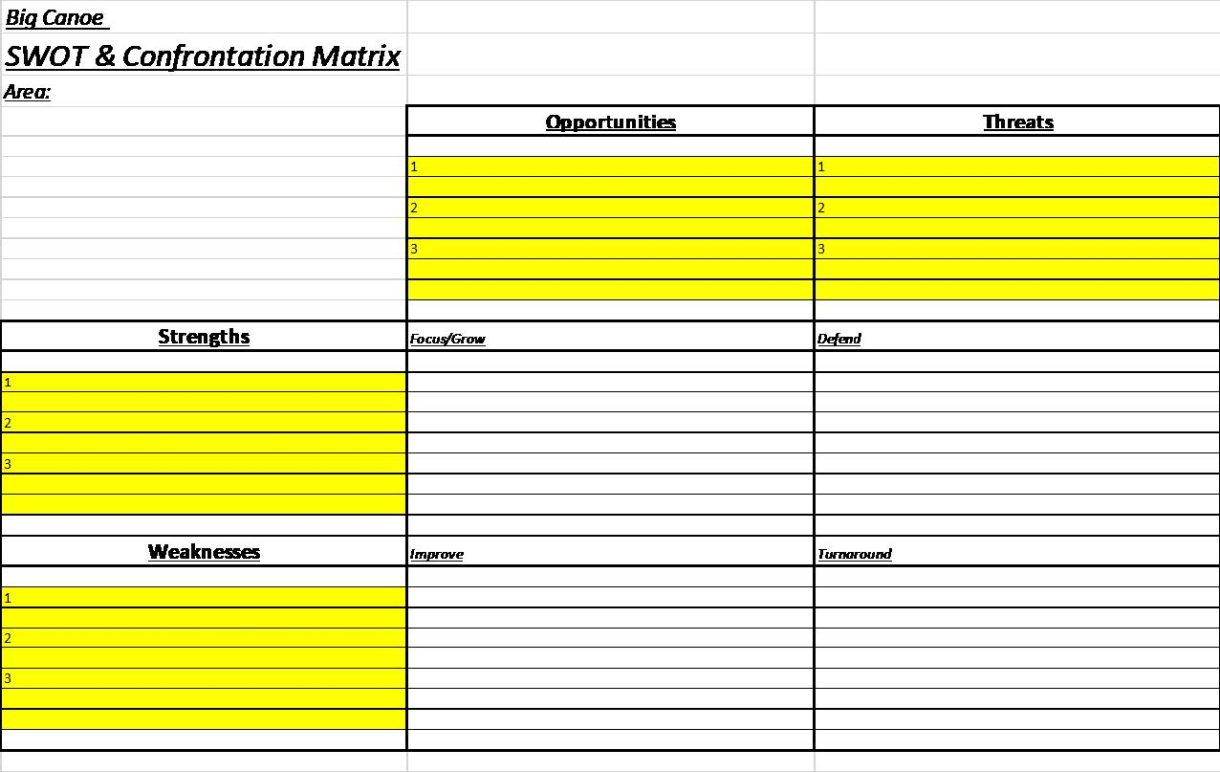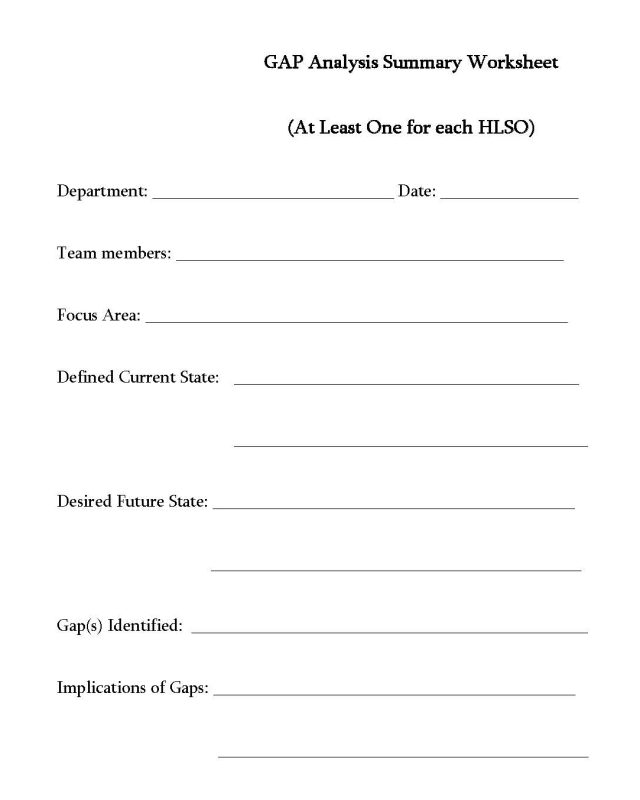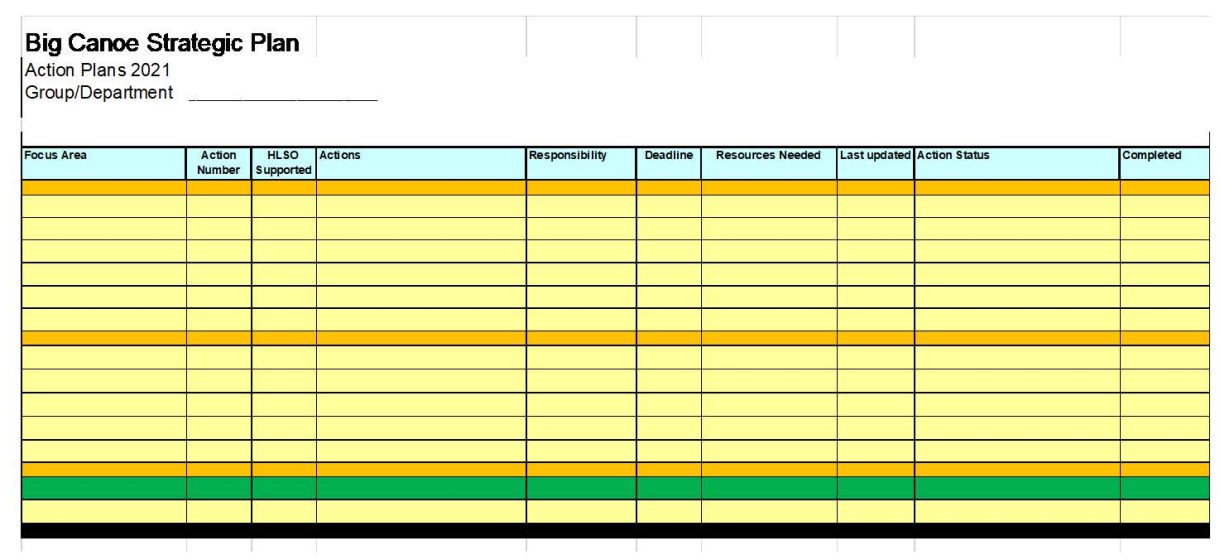Strategic Plan Deployment

Putting Strategic Planning to Work
The overall Mission, Vision, Values and High-Level Strategic
Objectives above have now been set for Big Canoe. The process we went through to get to this point should be reviewed every 3-5 years, but these are now essentially “set and settled”.

To put Strategic Planning to work in Big Canoe, each asset and amenity manager needs to put in place an annual planning process that includes SWOT analysis, Gap Analysis and Work Plan (Action Plans) that support the Mission, Vision, Values and High-Level Strategic Objectives of Big Canoe. Development of final annual work plans is an iterative process since the action plans must be supported by the budgeting process. So, initial workplans (let’s call them “proposed” or “preliminary” work plans) developed using the SWOT, GAP and Action Plan tools will be presented to the General Manager and the Finance Committee, who will provide budget/financing input for the “final” work plan. Asset and Amenities requiring strategic plans include the following. This list can be added to at the discretion of the General Manager.
Amenities - Golf Club, Food & Beverage (Including Clubhouse), Marina, Membership, Racquet Club, Wellness Center
Assets - Golf Operations, Landscaping, Public Safety, Public Works (infrastructure and buildings)
Other - Human Resources
The Long-Range Planning Committee also needs to include these tools in developing the Long Range Plans for Big Canoe and our Master Plan.
Operations and POA leadership need to use the Mission, Vision, Values and HLSO as the essential foundation through which strategic decisions for Big Canoe are passed.

Strategic Planning Tools
The rest of this manual includes the templates for SWOT, GAP Goals and Action Plans, along with more detailed description of how to use them. The “end in mind” are practical “action plans” with SMART” goals (described below) that support or overall High-Level Strategic Objectives.
A SWOT Analysis requires us to think about our community and responsibilities in a future-oriented context. Both the positive and negative things about us are identified and addressed, Strengths and Weaknesses consider ‘Internal’ factors, while Opportunities and Threats consider ‘external’ factors.
Strengths and Weaknesses are under your direct control and tend to focus on the present while Opportunities and Threats are future oriented and typically are outside of your direct control. It may be difficult to effect significant change of your Strengths and Weaknesses, but it is possible with a plan, patience, and time. You can plan and try to influence a positive outcome in as far as Opportunities and Threats are concerned but in the final
analysis, it not up to you.
A SWOT analysis is far from scientific. There’s no objective way of measuring how well you do one. It relies on your ability to observe and recall internal and external factors that can impact our community. It’s not about making accurate predictions so much as it is about knowing what to plan for.
Examples of Strengths and Weaknesses that may help ignite your analysis are;
• Community “culture”
• Community assets
• Geography
• Staff
• Partnerships
• Intellectual property
Examples of Opportunities and Threats might include;
• Regulations
• Competitors
• Economy
• Market size
• Trends
• Financing
Successfully completing the SWOT analysis requires introspection, openness to critique and candid self- assessment. Here are a few key thoughts and questions to help you start the process.
STRENGTHS - Internal Positive Factors
• What do we do exceptionally well?
• What advantages do we have?
• What valuable assets and resources do we have?
• What do our property owners identify as our strengths?
WEAKNESSES - Internal Negative Factors
• What could we do better?
• What do our property owners criticize us for?
• What do we receive complaints about?
• Where are we vulnerable?
• What could we improve?
OPPORTUNITIES - External Positive Factors
• What opportunities do we have but have not addressed?
• What new trends are there that we can capitalize upon?
THREATS - External Negative Factors
• Are any of our weaknesses likely to make us vulnerable?
• What obstacles do we face or are likely to face that hinder our achieving our objectives?
• Has there been or is it likely that there will be a significant change to who our customer is or their expectations?
• Are there economic factors that put our viability at risk?
Attached to this document is an Excel spreadsheet (Big Canoe SWOT 11.6.xlsx) to be used as a template for capturing the SWOT analysis. Here is what it looks like:

Note that the template combines the SWOT with a “Confrontation” matrix. The purpose of the Confrontation Matrix is to use the SWOT analysis to identify areas of focus and improvement, and areas where we may need to consider defensive actions or even a complete turnaround strategy. In Big Canoe’s case, we have a relatively
unique and successful community, so for now the focus should be on the “grow” and “improve” boxes. But the complete template is provided.
For example the intersection (or combination) of Strengths and Opportunities are possible action plans to focus on or to grow. The intersection of Opportunities and Weaknesses are possible areas of improvement. The use of the SWOT and Confrontation Matrix will be covered in specific group training sessions.
Gap Analysis is the process of comparing your current state to your desired future state. In other words, “where are we now vs. where we want to be (Vision). Since the High-Level Strategic Objectives have been derived from the Vision Statement, you should have at least one GAP analysis for each HLSO.
When completing the GAP analysis, everyone that participates must commit to the following.
• Be honest about your deficiencies. It can be hard to admit your failures but to perform an effective gap analysis, you'll need to be brutally honest about the things that are not working in your organization.
• Be honest about your strengths. Don't be too humble about what you've accomplished. You need to understand the positive aspects of your business to help you focus on the negative ones.
• Be realistic. The GAP analysis support the Action Plans, so be realistic, and pragmatic given your known constraints.
• Be specific. For every part of your gap analysis (current state, desired future state), you'll need to avoid vague statements or intangible outcomes. Be sure to include a mixture of qualitative and quantitative measures for both your current and future states.
Let’s review the Gap Analysis process that we will employ.
- 1. Define the Focus Areas: This can come out of the SWOT and Confrontation Matrix.
- 2. Assess the Current State of Each Focus Area. The key step in performing a gap analysis is gaining a clear understanding of where we are today, as it applies to the High Level Strategic Objectives. It is critical to be honest and candid in making this assessment of our current performance in each of the Focus Areas that we have defined as key to supporting the High Level Strategic Objectives.
The task in this step is simply to write a short, concise sentence that best describes the current state in each Focus Area. - 3. Identify the Desired Future State: For each of the Focus Areas, defined the specific future state, as identified in the Vision Statement and in support of the High Level Strategic Objectives, that you need to achieve.
- 4. Gap Analysis Summary Plan: Attached to this document is an Word Template (Big Canoe GAP 11.6.docx) to be used as a template for capturing the GAP analysis. To keep the GAP analyses strategic, there should be at least one GAP analysis for each Long Term Strategic Objective. Ask yourself, “where are we now (current situation) vs. where we want to be (Vision) for each of the High Level Strategic Objectives.” Here’s what the GAP Worksheet looks like:

Putting Strategic Planning to Work
The overall Mission, Vision, Values and High-Level Strategic
Objectives above have now been set for Big Canoe. The process we went through to get to this point should be reviewed every 3-5 years, but these are now essentially “set and settled”.


Goals & Action Plans
Once the GAP Analyses are complete, it’s time to establish specific goals and action plans that “reduce or eliminate the GAP”. In other words, “what are we going to do to make sure we are making progress towards achieving our Vision. “Action Plans” are also called “Work Plans”, and they define and guide our work activities that help us achieve our goals.
Each Big Canoe Department will engage in the process of setting Goals and Action Plans, both at the department level, and the individual level. The purpose of this process is to support one or more of the Big Canoe strategic objectives.
Overview
- Goals are the outcomes you intend to achieve, whereas action plans are the specific actions and measurable steps that you need to take to achieve a goal.
- Goals are general statements of what is to be achieved or the desired long-term outcome. A goal describes where your organization wants to be in the future, but unlike action plans, it doesn’t detail how you get there.
- Action Plans are the specific actions and measurable steps you and your organization (team) must take to reach its goals.
Department /Individual Goals
Goals should be accompanied by a timeframe and specific tangible expectations. We will be using the S.M.A.R.T. criteria and objective setting method in this process . S.M.A.R.T. is an acronym for:
- Specific: Objectives are clear and concrete. Real Metrics can be assigned and there are deadlines that must be tracked. Be specific about what you want to accomplish when writing the goal. It may be helpful to complete the ‘W’ drill and address WHO, WHAT, and by WHEN.
- Measurable: Make sure that you can track the success of your objective. What is the key performance indicator (KPI) that you are going to track
- Achievable: Make the objective challenging but not un-realistic. Don’t try to conquer the world in one day!
- Relevant: Is the objective in line with your longer term goals and is it aligned with the Big Canoe Vision and hLSOs?
- Time-bound: Your objective must have a targeted completion date or a clearly defined deadline.
This process is intended to help focus departmental and personal resources that support one or more of Big Canoe’s High Level Strategic Objectives while simultaneously allowing for you to functionally perform your major job responsibilities.
Attached to this document is an Word Template (Big Canoe SMART Goals 11.6) to be used as a template for developing Goals. Here’s what the SMART Goals Worksheet looks like:
S.M.A.R.T Goals/Objectives Worksheet
S - SPECIFIC
What do you want to accomplish, who needs to be involved, when will this be completed? What strategic goal does this support?
M - MEASURABLE
How will you measure your progress and know you have successfully met your goal?
A - ACHIEVABLE
Do you have the skills and resources required to successfully achieve this objective if not, can you obtain them? Is the time frame to accomplish realistic?
R - RELEVANT
Why am I setting this objective now? Is it aligned with the overall vision and one of the strategic goals? Why is this important?
T - TIME BOUND
What is the deadline and is it realistic?
Action Plans
An action plan is a checklist for the steps or tasks you need to complete in order to achieve the goals you have set.
Components of an action plan include
• A well-defined description of the goal to be achieved
• Tasks/ steps that need to be carried out to reach the goal
• People who will be in charge of carrying out each task
• When will these tasks be completed (deadlines and milestones)
• Resources needed to complete the tasks
• Measures to evaluate progress
Here are some benefits of an action plan you should know;
• It gives you a clear direction. As an action plan highlights exactly what steps to be taken and when they should be completed, you will know exactly what you need to do.
• Having your goals written down and planned out in steps will give you a reason to stay motivated and committed throughout the project.
• With an action plan, you can track your progress toward your goal.
• Since you are listing down all the steps you need to complete in your action plan, it will help you prioritize your tasks based on effort and impact.
Step 1: Define your end goal (Utilize the S.M.A.R.T. Goal process previously defined.
Step 2: Describe the steps to be followed (Actions) As necessary, further define the projects that make up this focus area.
Step 3: Prioritize tasks and add deadlines
It’s time to reorganize the list by prioritizing the tasks. Some steps, you may need to prioritize as they can be blocking other sub-steps.
Add deadlines, and make sure that they are realistic. Consult with the person responsible for carrying it out to understand his or her capacity before deciding on deadlines.
Step 4: Set Milestones
Milestones can be considered mini goals leading up to the main goal at the end. The advantage of adding milestones is that they give the team members to look forward to something and help them stay motivated even though the final due date is far away.
Start from the end goal and work your way back as you set milestones. Remember not to keep too little or too much time in between the milestone you set. It’s a best practice to space milestones two weeks apart.
Step 5: Identify the resources needed
Before you start your project, it’s crucial to ensure that you have all the necessary resources at hand to complete the tasks. And if they are not currently available, you need to first plan to acquire them.
This should also include your budget. You can assign a column of your action plan to mark the cost of each task if there are any.
Step 6: Visualize your action plan
The point of this step is to create something that everyone can understand at a glance and that can be shared with everyone. Whatever format that you are comfortable using to manage this process, make sure that it clearly communicates the tasks, task owners, deadlines, resources, etc. This document should be easily accessible to everyone and should be editable.
Step 7: Monitor, evaluate and update
Allocate some time to evaluate the progress you’ve made with your team. You can mark tasks that are completed as done on this final action plan, bringing attention to how you’ve progressed toward the goal.
This will also bring out the tasks that are pending or delayed, in which case you need to figure out why and find suitable solutions. And then update the action plan accordingly.
Action Plan Template
Attached to this document is an Excel Spreadsheet Template (Big Canoe Action Plans 11.6.docx) to be used as a template for summarizing and communicating Action plans. Here’s what it looks like:

Conclusion & Summary
The overall strategic Mission, Vision, Values and High-Level Strategic Objectives have been set by the Strategic Planning Committee and approved by the POA Board. Now it’s time for Big Canoe Management, employees, and Property Owner Volunteers to develop and implement strategic plans that help us move towards achieving our Strategic Vision and High-Level Strategic Objectives.
The first half of this manual presents and explains the Mission, Vision, Values and High-Level Strategic Objectives of Big Canoe.

The second half of this manual provide 4 templates that assist in strategic plan development. These are:
- 1. SWOT Analysis Worksheet. (Big Canoe SWOT 11.6.xlxs)
2. GAP Analysis Worksheet (Big Canoe GAP 11.6.docx)
3. SMART Goals Worksheet (Big Canoe SMART Goals 11.6.docx.
4. Action Plans Summary (Big Canoe Action Plans 11.6.xlxs)
This is the simplified process for Strategic Planning that Big Canoe will implement on an ongoing basis. The Process will be led and managed by the General Manager, to ensure our success as a community and satisfaction of our property owners. The POA Board will charter a new Strategic Planning Committee every 5 years to review and revise this process for Strategic Planning. This includes conducting a new Voice of the Community every 5 years, and reviewing and updating the Mission, Values, and Vision Statements and the High Level Strategic Objectives.
